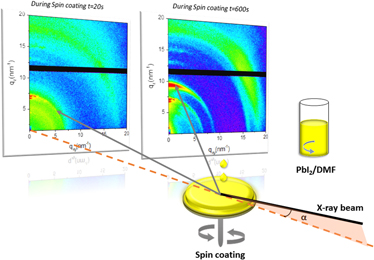Crossref Citations
This article has been cited by the following publications. This list is generated based on data provided by
Crossref.
Ugur, Esma
Sheikh, Arif D.
Munir, Rahim
Khan, Jafar I.
Barrit, Dounya
Amassian, Aram
and
Laquai, Frédéric
2017.
Improved Morphology and Efficiency of n–i–p Planar Perovskite Solar Cells by Processing with Glycol Ether Additives.
ACS Energy Letters,
Vol. 2,
Issue. 9,
p.
1960.
Sheikh, Arif D.
Munir, Rahim
Haque, Md Azimul
Bera, Ashok
Hu, Weijin
Shaikh, Parvez
Amassian, Aram
and
Wu, Tom
2017.
Effects of High Temperature and Thermal Cycling on the Performance of Perovskite Solar Cells: Acceleration of Charge Recombination and Deterioration of Charge Extraction.
ACS Applied Materials & Interfaces,
Vol. 9,
Issue. 40,
p.
35018.
Becker, Markus
and
Wark, Michael
2018.
Recent Progress in the Solution-Based Sequential Deposition of Planar Perovskite Solar Cells.
Crystal Growth & Design,
Vol. 18,
Issue. 8,
p.
4790.
Xu, Jixian
Voznyy, Oleksandr
Liu, Mengxia
Kirmani, Ahmad R.
Walters, Grant
Munir, Rahim
Abdelsamie, Maged
Proppe, Andrew H.
Sarkar, Amrita
García de Arquer, F. Pelayo
Wei, Mingyang
Sun, Bin
Liu, Min
Ouellette, Olivier
Quintero-Bermudez, Rafael
Li, Jie
Fan, James
Quan, Lina
Todorovic, Petar
Tan, Hairen
Hoogland, Sjoerd
Kelley, Shana O.
Stefik, Morgan
Amassian, Aram
and
Sargent, Edward H.
2018.
2D matrix engineering for homogeneous quantum dot coupling in photovoltaic solids.
Nature Nanotechnology,
Vol. 13,
Issue. 6,
p.
456.
Niu, Tianqi
Lu, Jing
Munir, Rahim
Li, Jianbo
Barrit, Dounya
Zhang, Xu
Hu, Hanlin
Yang, Zhou
Amassian, Aram
Zhao, Kui
and
Liu, Shengzhong (Frank)
2018.
Stable High‐Performance Perovskite Solar Cells via Grain Boundary Passivation.
Advanced Materials,
Vol. 30,
Issue. 16,
Quintero-Bermudez, Rafael
Gold-Parker, Aryeh
Proppe, Andrew H.
Munir, Rahim
Yang, Zhenyu
Kelley, Shana O.
Amassian, Aram
Toney, Michael F.
and
Sargent, Edward H.
2018.
Compositional and orientational control in metal halide perovskites of reduced dimensionality.
Nature Materials,
Vol. 17,
Issue. 10,
p.
900.
Zhong, Yufei
Munir, Rahim
Li, Jianbo
Tang, Ming-Chun
Niazi, Muhammad R.
Smilgies, Detlef-M.
Zhao, Kui
and
Amassian, Aram
2018.
Blade-Coated Hybrid Perovskite Solar Cells with Efficiency > 17%: An In Situ Investigation.
ACS Energy Letters,
Vol. 3,
Issue. 5,
p.
1078.
Zhang, Yalan
Wang, Peijun
Tang, Ming-Chun
Barrit, Dounya
Ke, Weijun
Liu, Junxue
Luo, Tao
Liu, Yucheng
Niu, Tianqi
Smilgies, Detlef-M
Yang, Zhou
Liu, Zhike
Jin, Shengye
Kanatzidis, Mercouri G.
Amassian, Aram
Liu, Shengzhong Frank
and
Zhao, Kui
2019.
Dynamical Transformation of Two-Dimensional Perovskites with Alternating Cations in the Interlayer Space for High-Performance Photovoltaics.
Journal of the American Chemical Society,
Vol. 141,
Issue. 6,
p.
2684.
Tang, Ming-Chun
Barrit, Dounya
Munir, Rahim
Li, Ruipeng
Barbé, Jérémy M.
Smilgies, Detlef-M.
Del Gobbo, Silvano
Anthopoulos, Thomas D.
and
Amassian, Aram
2019.
Bismuth‐Based Perovskite‐Inspired Solar Cells: In Situ Diagnostics Reveal Similarities and Differences in the Film Formation of Bismuth‐ and Lead‐Based Films.
Solar RRL,
Vol. 3,
Issue. 7,
Matteocci, Fabio
Vesce, Luigi
Kosasih, Felix Utama
Castriotta, Luigi Angelo
Cacovich, Stefania
Palma, Alessandro Lorenzo
Divitini, Giorgio
Ducati, Caterina
and
Di Carlo, Aldo
2019.
Fabrication and Morphological Characterization of High-Efficiency Blade-Coated Perovskite Solar Modules.
ACS Applied Materials & Interfaces,
Vol. 11,
Issue. 28,
p.
25195.
Barrit, Dounya
Cheng, Peirui
Tang, Ming‐Chun
Wang, Kai
Dang, Hoang
Smilgies, Detlef‐M.
Liu, Shengzhong (Frank)
Anthopoulos, Thomas D.
Zhao, Kui
and
Amassian, Aram
2019.
Impact of the Solvation State of Lead Iodide on Its Two‐Step Conversion to MAPbI3: An In Situ Investigation.
Advanced Functional Materials,
Vol. 29,
Issue. 47,
Dang, Hoang X.
Wang, Kai
Ghasemi, Masoud
Tang, Ming-Chun
De Bastiani, Michele
Aydin, Erkan
Dauzon, Emilie
Barrit, Dounya
Peng, Jun
Smilgies, Detlef-M.
De Wolf, Stefaan
and
Amassian, Aram
2019.
Multi-cation Synergy Suppresses Phase Segregation in Mixed-Halide Perovskites.
Joule,
Vol. 3,
Issue. 7,
p.
1746.
Liu, Lang
Bai, Yang
Zhang, Xiao
Shang, Yuequn
Wang, Chenyue
Wang, Hao
Zhu, Cheng
Hu, Chen
Wu, Jiafeng
Zhou, Huanping
Li, Yujing
Yang, Shihe
Ning, Zhijun
and
Chen, Qi
2020.
Cation Diffusion Guides Hybrid Halide Perovskite Crystallization during the Gel Stage.
Angewandte Chemie,
Vol. 132,
Issue. 15,
p.
6035.
Zhao, Yong‐Yan
Sun, Wu‐Ji
Wang, Min‐Gang
He, Jing‐Hui
and
Lu, Jian‐Mei
2020.
Flexible Ternary Resistive Memory from Organic Bulk Heterojunction.
Advanced Materials Technologies,
Vol. 5,
Issue. 1,
Kirmani, Ahmad R.
Mansour, Ahmed E.
Yang, Chen
Munir, Rahim
El-Zohry, Ahmed M.
Mohammed, Omar F.
Amassian, Aram
and
Cozzoli, P. Davide
2020.
Facile and noninvasive passivation, doping and chemical tuning of macroscopic hybrid perovskite crystals.
PLOS ONE,
Vol. 15,
Issue. 3,
p.
e0230540.
Wang, Yafei
Xu, Hao
Wang, Feng
Liu, Detao
Chen, Hao
Zheng, Hualin
Ji, Long
Zhang, Peng
Zhang, Ting
Chen, Zhi David
Wu, Jiang
Chen, Li
and
Li, Shibin
2020.
Unveiling the guest effect of N-butylammonium iodide towards efficient and stable 2D-3D perovskite solar cells through sequential deposition process.
Chemical Engineering Journal,
Vol. 391,
Issue. ,
p.
123589.
Liu, Lang
Bai, Yang
Zhang, Xiao
Shang, Yuequn
Wang, Chenyue
Wang, Hao
Zhu, Cheng
Hu, Chen
Wu, Jiafeng
Zhou, Huanping
Li, Yujing
Yang, Shihe
Ning, Zhijun
and
Chen, Qi
2020.
Cation Diffusion Guides Hybrid Halide Perovskite Crystallization during the Gel Stage.
Angewandte Chemie International Edition,
Vol. 59,
Issue. 15,
p.
5979.
Barrit, Dounya
Cheng, Peirui
Darabi, Kasra
Tang, Ming‐Chun
Smilgies, Detlef‐M.
Liu, Shengzhong (Frank)
Anthopoulos, Thomas D.
Zhao, Kui
and
Amassian, Aram
2020.
Room‐Temperature Partial Conversion of α‐FAPbI3Perovskite Phase via PbI2Solvation Enables High‐Performance Solar Cells.
Advanced Functional Materials,
Vol. 30,
Issue. 11,
Khan, Jafar I.
Sheikh, Arif D.
Alamoudi, Maha A.
Barrit, Dounya
Ugur, Esma
Laquai, Frédéric
and
Amassian, Aram
2020.
Impact of Residual Lead Iodide on Photophysical Properties of Lead Triiodide Perovskite Solar Cells.
Energy Technology,
Vol. 8,
Issue. 3,
Wang, Jian
Wang, Weijia
Chen, Yonghua
Song, Lin
and
Huang, Wei
2021.
Growth and Degradation Kinetics of Organic–Inorganic Hybrid Perovskite Films Determined by In Situ Grazing‐Incidence X‐Ray Scattering Techniques.
Small Methods,
Vol. 5,
Issue. 12,
